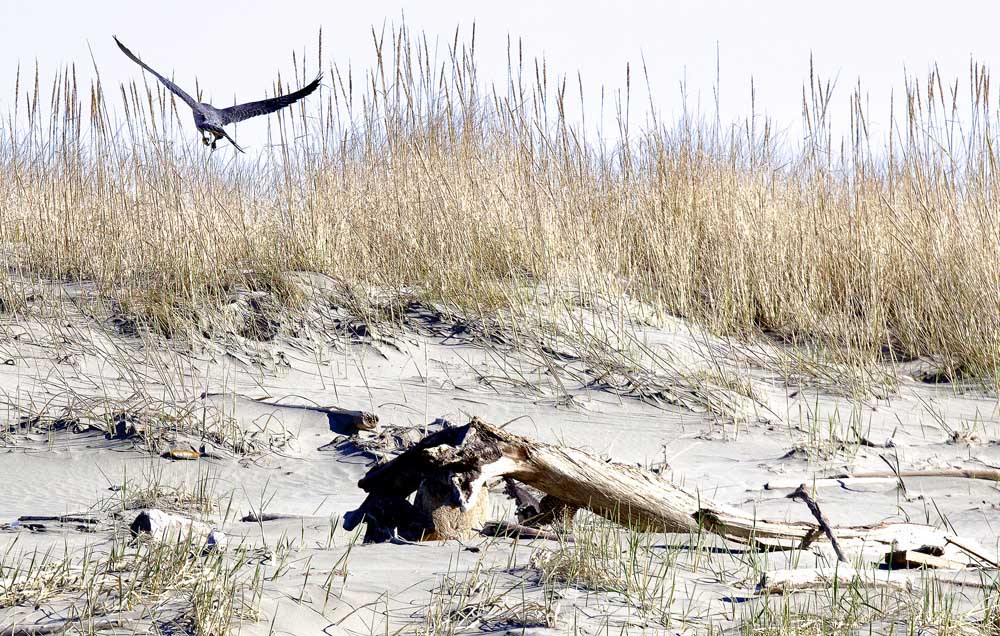Raptors in action: It’s a steal
Published 9:30 am Monday, February 28, 2022

- The chase is over. Can you find the second peregrine?
PENINSULA — The January 2022 winter raptor survey was one of the most exciting and entertaining birding days in quite some time.
Trending
As I have mentioned, the territory Susan Stauffer and I cover is the Long Beach Peninsula. We begin on the beach at Beard’s Hollow. The beach is divided into sections. Each section is surveyed for raptors and recorded being sure not to double count the birds.
This is raptor country
Bald eagles and peregrine falcons are the raptors most often seen on the beach. On occasion, a northern harrier will fly by, dipsy-doodling over the dunes as it searches for a tasty meal. We then exit the beach at the Oysterville approach and drive along the road though town and on to Stackpole Road and then to Sandridge. This part of the route is where we see red-tailed hawks and American kestrels. Bald eagles are seen in large numbers as well.
Raptors are counted from Leadbetter Point to the Ilwaco harbor. There are various stopping points along the way so that raptors using Willapa bay, and its shoreline can be counted.
Eagle kleptos
Bald eagles are always seen in large numbers on the mudflats of Willapa Bay. Six sub-adult bald eagles were foraging on the bay or lying in wait for an opportunity to snag an unsuspecting duck. Twelve adult eagles were utilizing the bay as well. The sub-adults often flew into the conifers along the shore to survey the mudflats looking for their opportunity.
Today’s story begins with one of the adult bald eagles seen on the beach. It was a kleptoparasite and its host was a common raven. Kleptoparasitism is defined as a foraging strategy in which an animal obtains food by stealing it from other animals.
The raven was feeding on carrion that looked like a Hereford cow. A bald eagle was sitting a few feet from it and above but close to the carrion and the raven. Each time the raven pried a bit of meat off the carrion, it was flown at by the eagle. The raven then took off with its snack pursued by the eagle dive bombing at it until the harried raven was finally forced to drop its prize. The bald eagle then swooped down to retrieve the falling the treat! Lunch at last! This was kleptoparasitism behavior at its finest!
Bald eagles are well known for this behavior. Their favorite targets are common ravens and osprey. As exemplified by these two species, their targets are usually smaller in size and likely share the same range as the eagle. The bald eagle we saw on the beach was an expert at harrying the raven to the point where it dropped its lunch.
Dueling falcons
Other interesting behavior witnessed that day on the beach was courtesy of two peregrine falcons. Peregrine falcons are deemed by scientists to be the fastest animal on the planet! That was demonstrated with great style.
What looked like a first-year bird flew quietly onto a log. It seemed to be minding its own business, but I am sure it was actively on the hunt! Suddenly, out of nowhere an adult peregrine streaked in with great speed. It was on the attack. It appears to have been a territorial dispute or perhaps an attempt to drive off a potential suitor for the third adult peregrine that was sitting further down the ocean beach in the direction from which the attacking bird flew.
In any case, the adult peregrine was clearly unhappy with the presence of the other younger peregrine. Eventually, the two adult falcons were left alone to enjoy their part of the beach while the young falcon flew off to find another perch from which to hunt, out of harm’s way.
To witness one raptor stealing food from another and one unwittingly “stealing” territory from another made our day. The next time you are out birding, watch for these behaviors. They could happen before your very eyes almost anywhere here on the peninsula.
Happy birding!









